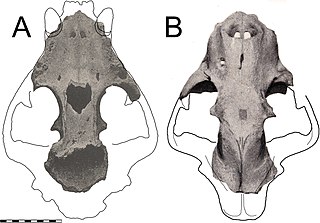Related Research Articles

Genyodectes is a genus of ceratosaurian theropod dinosaur from the Lower Cretaceous (Aptian) of South America. The holotype material was collected from the Cerro Barcino Formation, Cañadón Grande, Departamento Paso de Indios in the Chubut Province of Argentina and consists of an incomplete snout, including the premaxillae, portions of both maxillas, the right and left dentary, many teeth, a fragment of the left splenial, and parts of the supradentaries. These elements are generally poorly preserved and some are in articulation. The premaxilla of Genyodectes possesses relatively large and protruding teeth, similar to those of Ceratosaurus. The specific name, serus, means "late". In 2016 it was estimated to be 6.25 meters in length and 790 kg in weight.
Paraptenodytes brodkorbi is a proposed, but possibly invalid, species of extinct penguin in the genus Paraptenodytes. The bird was probably about the size of a king penguin. Known material is limited to a single humerus, Early Miocene in age, found in the Monte León Formation near Puerto San Julián in Santa Cruz Province, Argentina. It exists as an unnumbered specimen in the collection of the Museo Argentino de Ciencias Naturales.
Henricosborniidae is a family of extinct notoungulate mammals known from the Late Paleocene to Middle Eocene of Argentina, Bolivia and Brazil. The name honors U.S. paleontologist Henry Fairfield Osborn.

Niolamia is an extinct genus of South American meiolaniid turtle with a long and complex history. Like its relatives, Niolamia was a robust and heavily armored terrestrial turtle with large, horn like scales covering its head and a tail encased by rings of bone. This heavily armored build may have served the animal during intraspecific combat during courtship. Scans of the skull reveal that Niolamia likely had a great sense of smell but only low frequency hearing, indicating that these animals communicated more through chemical signals and smells than through sound.

Patagornis is a genus of extinct flightless predatory birds of the family Phorusrhacidae. Known as "terror birds", these lived in what is now Argentina during the Early and Middle Miocene; the Santa Cruz Formation in Patagonia contains numerous specimens. Patagornis was an agile, medium sized Patagornithine and was likely a pursuit predator.

Panthera onca mesembrina is an extinct subspecies of jaguar that was endemic to Patagonia in southern South America during the late Pleistocene epoch. It is known from several fragmentary specimens, the first of which found was in 1899 at "Cueva del Milodon" in Chile. These fossils were referred to a new genus and species "Iemish listai" by naturalist Santiago Roth, who thought they might be the bones of the mythological iemisch of Tehuelche folklore. A later expedition recovered more bones, including the skull of a large male that was described in detail by Angel Cabrera in 1934. Cabrera created a new name for the giant felid remains, Panthera onca mesembrina, after realizing that its fossils were near-identical to modern jaguars’. P. onca mesembrina's validity is disputed, with some paleontologists suggesting that it is a synonym of Panthera atrox.
Cruschedula is an enigmatic bird genus considered to be nomen dubium which consists of the single species Cruschedula revola.
The Iemisch is a supposed monster from Patagonia, specifically in the mountains near the Lake Colhué region. First attested to by Florentino Ameghino in 1897, a full study on the creature was published in the 1955 book On the Track of Unknown Animals.
Ernestokokenia is an extinct genus of mammal, belonging to the Didolodontidae. It lived during the Early Eocene and the Middle Eocene, and its fossils were discovered in South America.
Paulogervaisia is an extinct genus of mammal, belonging to the family Didolodontidae. Its fossilized remains have been found in South America.
Polymorphis is an extinct genus of litopterns belonging to the family Macraucheniidae. It lived during the Middle Eocene of Argentina.

Anisolambda is an extinct genus of litoptern. It lived from the Late Paleocene to the Middle Eocene in what is now Argentina.
Proectocion is an extinct genus of adianthid litoptern. It lived during the Early Eocene, in what is now South America.
Xesmodon is an extinct genus of mammal. It lived from the Middle to the Late Eocene, in what is today South America.
Henricosbornia is an extinct genus of henricosborniid notoungulate that lived from the Late Paleocene to the Middle Eocene of what is now Argentina and Brazil.

Periphragnis is an extinct genus of isotemnid notoungulates that lived from the Middle Eocene to the Early Oligocene in what is now Argentina and Chile.
Rhyphodon is an extinct genus of notoungulate, who lived from the Middle to the Late Eocene in what is today South America.
Oldfieldthomasia is an extinct genus of Notoungulate, probably related to the suborder Typotheria. It lived during the Middle Eocene, in what is today South America.

Cochilius is an extinct genus of interatheriid notoungulate that lived between the Late Oligocene and the lower Miocene in what is now Argentina.
Machlydotherium is an extinct genus of cingulate of uncertain systematic affinities, perhaps belonging to the Pampatheriidae. It lived from the Middle Eocene to the Early Oligocene, and its fossilized remains were found in South America.
References
- 1 2 3 4 Simpson 1948, p. 142.
- 1 2 Roth 1899, p. 385.
- ↑ Palmer 1904, p. 563.
- ↑ Palmer 1904, p. 910.
Works cited
- Palmer, T. S. (1904), Index generum mammalium: a list of the genera and families of mammals
- Roth, Santiago (1899). "Aviso preliminar sobre mamíferos mesozóicos encontrados en Patagonia". Revista del Museo de La Plata. 9: 381–388.
- Simpson, George Gaylord (1948-07-15). "The beginning of the age of mammals in South America". Bulletin of the American Museum of Natural History. 91: 1–232.








